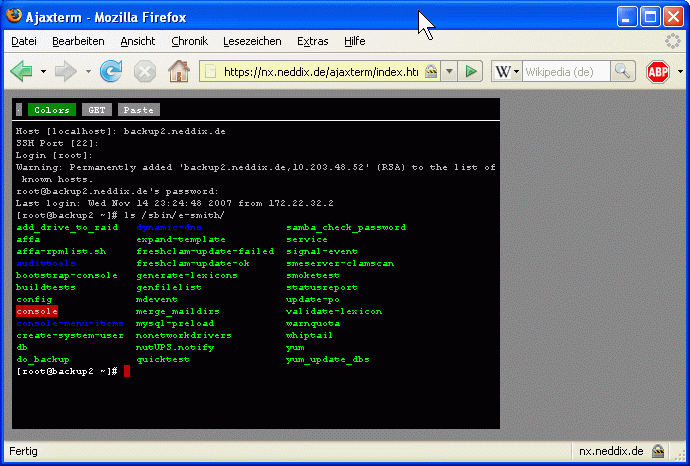Ajaxterm
Maintainer
Michael Weinberger
Introduction
Ajaxterm is a web based terminal. See http://antony.lesuisse.org/qweb/trac/wiki/AjaxTerm
Download
smeserver-ajaxterm-1.0.4-0.noarch.rpm
Installation
yum localinstall smeserver-ajaxterm-1.0.4-0.noarch.rpm
This installs and starts the Ajaxterm service. There is no need for the signal-event post-upgrade/reboot
Configuration
The Ajaxterm service is configurable by properties of the ajaxterm record in the SME server configuration database.
Restrict to login on localhost
config setprop Ajaxterm allowOnlyLocalhost yes service ajaxterm restart
Only a login to local host is possible (default setting). Ajaxterm runs the 'su --login USER' command to login. You are asked for a username and password
Allow ssh login on all hosts
config setprop Ajaxterm allowOnlyLocalhost no service ajaxterm restart
Ajaxterm runs the 'ssh' command to login to a host. You are asked for hostname or IP, ssh port, username and password. If localhost or 127.0.0.1 is given as the host Ajaxterm falls back to the 'su --login USER' login command.
Browser login (Basic Auth)
By default login with user admin is required on browser login. You can change this to any other user or a list of users separated by blanks.
config setprop Ajaxterm basicAuthUsers "user [user] ..." expand-template /etc/httpd/conf/httpd.conf service httpd-e-smith restart
Ajaxterm service port
By default Ajaxterm runs as a service (a python script) listening on port 8022. You can change the port using the following commands:
config setprop Ajaxterm servicePort NEWPORT expand-template /etc/httpd/conf/httpd.conf service httpd-e-smith restart service ajaxterm restart
Usage
Point your browser to https://yourdomain.com/ajaxterm/index.html
- Login in to browser prompt as admin.
- Login to shell access as any user, NB, you may need to enter the servername at Host and port and SSH Port depending on your configuration.
